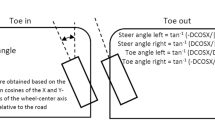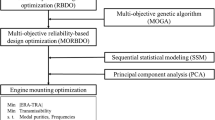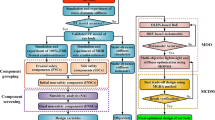Abstract
Tolerance optimization that considers variances of design variables should be performed before beginning the manufacturing process from a cost-effective perspective in the design process. The authors used a genetic algorithm and the process capability index (Cpk) to solve the robust objectives and probability constraints and to formulate a constrained optimization problem into an unconstrained one. The design space provided by the Cpk-values of weight and stress on the lower arm of a vehicle’s suspension was explored by using the central composite design method and the 2nd order Taylor series expansion. The optimal solutions were found via the genetic algorithm, in which the Cpk-values took into account the variances occurring in a design variable’s tolerances. The mean and standard deviation of Mass and Smax were predicted by using the 2nd order Taylor series expansion and the 2nd order polynomial response surface models generated from the central composite design method. The Cpk of Mass and Smax were calculated, where the Pareto set was generated by maximizing the Cpk-values via the MOGA (Multi-Objective Genetic Algorithm). From the Pareto set, optimal alternatives were selected and verified by simulated results from FE (Finite Element) analysis and Monte-Carlo simulation.
Similar content being viewed by others
Abbreviations
- C pk :
-
process capability index
- DV_SD :
-
objective function
- LSL :
-
lower specification limit
- USL :
-
upper specification limit
- R Square :
-
coefficient of determination
- R SquareAdj :
-
adjusted coefficient of determination
- g(x) :
-
constraints
- x(x) :
-
design variables
- y(x) :
-
objective functions(responses)
- µ(x) :
-
mean value of design variables
- σ(x) :
-
standard deviation value of design variables
References
Phadke, M. S., “Quality Engineering using Robust Design,” Prentice Hall PTR Upper Saddle River, pp. 13–40, 1989.
Seo, S. I., Lee, M. K., Kim, S. J., and Kim, N., “Robust Optimum Design of a Bearingless Rotation Motor using the Kriging Model,” Int. J. Precis. Eng. Manuf., Vol. 12, No. 6, pp. 1043–1050, 2011.
Del Castillo, E., “Process Optimization: a Statistical Approach,” Springer, pp. 109–152, 2007.
Parkinson, A., Sorensen, C., and Pourhassan, N., “A General Approach for Robust Optimal Design,” Journal of Mechanical Design, Vol. 115, No. 1, pp. 74–80, 1993.
Kane, V. E., “Process Capability Indices,” Journal of Quality Technology, Vol. 18, No. 1, pp. 41–52, 1986.
Hemin, M. M., Alokaidi, S. H., and Laiq, A., “Optimization of Lower Arm Vehicle Using Response Surface Methodology,” Journal of Advanced Science & Engineering Research, Vol. 1, No. 2, pp. 150–164, 2011.
Hemin, M. M., Rahman, M. M., and Omar, R. M., “Novel Design of Lower Arm Vehicle Using Finite Element Analysis and Statistical Method,” Journal of Advanced Science and Engineering Research, Vol. 2, No. 1, pp. 27–39, 2012.
Lee, K. K., Park, C. K., and Han, S. H., “Robust Design of Railway Vehicle Suspension using a Process Capability Index,” Journal of Mechanical Science and Technology, Vol. 24, No. 1, pp. 215–218, 2010.
Gen, M. and Cheng, R., “Genetic Algorithms and Engineering Optimization,” John Wiley & Sons, pp. 1–17, 2000.
De-Jong, K. A., “An Analysis of the Behavior of a Class of Genetic Adaptive Systems,” Ph.D. Thesis, University of Michigan, pp. 15–47, 1975.
Chelouah, R. and Siarry, P., “A Continuous Genetic Algorithm Designed for the Global Optimization of Multimodal Functions,” Journal of Heuristics, Vol. 6, No. 2, pp. 191–213, 2000.
Konak, A., Coit, D. W., and Smith, A. E., “Multi-Objective Optimization using Genetic Algorithms: A Tutorial,” Reliability Engineering & System Safety, Vol. 91, No. 9, pp. 992–1007, 2006.
Coello, C. C., Lamont, G. B., and Van Veldhuizen, D. A., “Evolutionary Algorithms for Solving Multi-Objective Problems,” Springer, pp. 61–111, 2007.
Farina, M., “A Minimal Cost Hybrid Strategy for Pareto Optimal Front Approximation,” Evolutionary Optimization, Vol. 3, No. 1, pp. 41–52, 2001.
Farina, M., “A Neural Network based Generalized Response Surface Multiobjective Evolutionary Algorithm,” Proc. of the Congress on Evolutionary Computation, Vol. 1, pp. 956–961, 2002.
Lian, Y. and Liou, M., “Multiobjective Optimization Using Coupled Response Surface Model and Evolutionary Algorithm,” AIAA Journal, Vol. 43, No. 6, pp. 1316–1325, 2005.
Chung, H. and Alonso, J. J., “Multiobjective Optimization Using Approximation Model-based Genetic Algorithms,” Proc. of 10th AIAA/ISSMO Symposium on Multidisciplinary Analysis and Optimization, AIAA 2004-4325, 2004.
Fang, J., Rais-Rohani, M., and Horstemeyer, M. F., “Multiobjective Crashworthiness Optimization with Radial Basis Funtions,” Proc. of 10th AIAA/ISSMO Multidisciplinary Analysis and Optimization Conference, AIAA 2004-4487, 2004.
Vlahinos, A. and Kelkar, S., “Designing for Six-Sigma Quality with Robust Optimization Using CAE,” SAE Technical Paper 2002-01-2017, 2002.
SAS Institute Inc., “JMP 10 Modeling and Multivariate Methods,” pp. 55–66, 2012.
Liu, C. and Lawrence Yao, Y., “Optimal and Robust Design of the Laser Forming Process,” Journal of Manufacturing Processes, Vol. 4, No. 1, pp. 52–66, 2002.
Author information
Authors and Affiliations
Corresponding author
Rights and permissions
About this article
Cite this article
Lee, KK., Ro, YC. & Han, SH. Tolerance optimization of a lower arm by using genetic algorithm and process capability index. Int. J. Precis. Eng. Manuf. 15, 1001–1007 (2014). https://doi.org/10.1007/s12541-014-0428-4
Received:
Revised:
Accepted:
Published:
Issue Date:
DOI: https://doi.org/10.1007/s12541-014-0428-4




